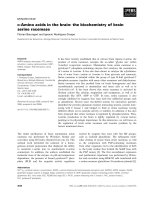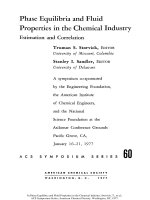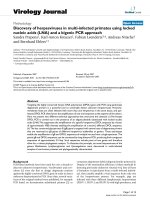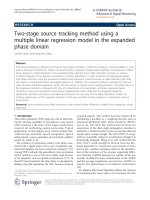Nucleic acids in the gas phase
Bạn đang xem bản rút gọn của tài liệu. Xem và tải ngay bản đầy đủ của tài liệu tại đây (7.94 MB, 297 trang )
Physical Chemistry in Action
Valérie Gabelica Editor
Nucleic
Acids in the
Gas Phase
www.pdfgrip.com
Physical Chemistry in Action
For further volumes:
/>
www.pdfgrip.com
.
www.pdfgrip.com
Vale´rie Gabelica
Editor
Nucleic Acids in the Gas
Phase
www.pdfgrip.com
Editor
Vale´rie Gabelica
Universite´ de Bordeaux
Institut Europe´en de Chimie et Biologie
Pessac
France
U869 ARNA Laboratory (Inserm/Univ. Bordeaux)
Institut Europe´en de Chimie et Biologie
Pessac
France
ISSN 2197-4349
ISSN 2197-4357 (electronic)
ISBN 978-3-642-54841-3
ISBN 978-3-642-54842-0 (eBook)
DOI 10.1007/978-3-642-54842-0
Springer Heidelberg New York Dordrecht London
Library of Congress Control Number: 2014946293
# Springer-Verlag Berlin Heidelberg 2014
This work is subject to copyright. All rights are reserved by the Publisher, whether the whole or part
of the material is concerned, specifically the rights of translation, reprinting, reuse of illustrations,
recitation, broadcasting, reproduction on microfilms or in any other physical way, and transmission or
information storage and retrieval, electronic adaptation, computer software, or by similar or dissimilar
methodology now known or hereafter developed. Exempted from this legal reservation are brief excerpts
in connection with reviews or scholarly analysis or material supplied specifically for the purpose of being
entered and executed on a computer system, for exclusive use by the purchaser of the work. Duplication
of this publication or parts thereof is permitted only under the provisions of the Copyright Law of the
Publisher’s location, in its current version, and permission for use must always be obtained from
Springer. Permissions for use may be obtained through RightsLink at the Copyright Clearance Center.
Violations are liable to prosecution under the respective Copyright Law.
The use of general descriptive names, registered names, trademarks, service marks, etc. in this
publication does not imply, even in the absence of a specific statement, that such names are exempt
from the relevant protective laws and regulations and therefore free for general use.
While the advice and information in this book are believed to be true and accurate at the date of
publication, neither the authors nor the editors nor the publisher can accept any legal responsibility for
any errors or omissions that may be made. The publisher makes no warranty, express or implied, with
respect to the material contained herein.
Printed on acid-free paper
Springer is part of Springer Science+Business Media (www.springer.com)
www.pdfgrip.com
Preface
Laboratory sciences have bloomed with a variety of techniques to decipher the
properties of the molecules of life. Physical chemists and chemical physicists
approach the problem by isolating molecules and ruthlessly dissecting them with
a variety of tools. One particular way to isolate molecules is to isolate them from
their solvent environment. The specific advantages are twofold. First, stripping
biomolecules from the solvent makes them amenable to mass spectrometry analysis. Second, isolating the molecules from their solvent enables one to study their
intrinsic properties. Besides their mass, these properties can be the molecules’
structure (from atom connectivity to tridimensional structure), their spectroscopic
properties, or their reactivity (for example, with photons, electrons, free radicals,
ions, or other molecules) in well-defined energetic conditions. Gas-phase
approaches therefore constitute a category of techniques with their own instrumentation, theoretical approaches, and rules for data interpretation.
The objective of this book is to bridge the gap between communities. On the one
hand, it aims to give physical chemists a broader view of the potential biological
applications of the techniques they develop. On the other hand, the book aims to
give chemists, biophysicists, biochemists, molecular biologists, and pharmacologists novel insight into the ways gas-phase techniques can bring unique
answers to new types of questions.
Book Outline
This volume is divided into two parts: (I) Methods and (II) Applications.
Part I—Methods—introduces techniques used to investigate the properties of
nucleic acids in the absence of solvent and key results: how to transfer nucleic acids
from the condensed phase to the gas phase (Chap. 2), the fate of large nucleic acids
in the gas phase according to molecular simulations and ion mobility spectrometry
experiments (Chap. 3), interaction of nucleic acids in the gas phase with electrons
(Chap. 4) or photons (Chap. 5), and gas-phase fragmentation pathways (Chap. 6).
Some of these techniques are of course common to the investigation of other
v
www.pdfgrip.com
vi
Preface
categories of biomolecules (e.g., proteins), but we will highlight here the
specificities pertaining to nucleic acid studies.
Part II—Applications—illustrates with four examples the use of gas-phase
physicochemical approaches to solve specific questions from fields as diverse as
molecular biology, with the sequencing of large RNA (Chap. 7), human health,
with the characterization and quantification of nucleic acid modifications resulting
from photodamage (Chap. 8), pharmacology, with the screening of drug
interactions with nucleic acid targets (Chap. 9), or structural biology, with the
characterization of RNA folding by mass spectrometry-based approaches
(Chap. 10). This list of potential applications is by far not exhaustive, but the key
take-home message lies elsewhere. Each of these chapters underlines in its own
way the crucial importance of understanding the fundamental physical principles
driving nucleic acid structure and reactivity in the gas phase, to conceive tailormade approaches to solve important problems.
Acknowledgments
I first wish to thank my past team in Lie`ge and my new team in Bordeaux for their
support in this research. In particular, I wish to thank Fre´de´ric Rosu, who was part
of both and constantly supported me in this adventure of studying nucleic acids in
the gas phase. From the Lie`ge University years, I wish to thank Edwin De Pauw,
Claude Houssier, and Nicolas Smargiasso, who were particularly eager to bridge
the gap between solution and gas-phase biophysical characterization of nucleic
acids. I thank Jean-Louis Mergny, director of the U869 ARNA laboratory in
Bordeaux, for having welcomed a gas-phase ion chemist in his nucleic acid
research lab, and my current team members, Adrien Marchand and Valentina
D’Atri, with whom the adventure continues.
This work would also not have been possible without the collaborators and
colleagues who made us discover various aspects either on the methodological or
on the applications side. I wish to thank Gilles Gre´goire, Philippe Dugourd,
Modesto Orozco, Mike Bowers, Joel Parks, Tom Rizzo, Manfred Kappes, Dimitra
Markovitsi, Alexandre Giuliani, Giorgia Oliviero, Janez Plavec, Naoki Sugimoto,
and the CLIO, FELIX, and Soleil teams for having welcomed me to their labs. I also
thank the members of COST action MP0802 on G-quadruplex nucleic acids, who
helped me to promote mass spectrometry and gas-phase physical chemistry among
nucleic acid scientists in Europe. Finally, I wish to dedicate this book to the
memory of Jean-Pierre Schermann, a profoundly humanistic scientist whose vision
was to bring together the fields of spectroscopy, mass spectrometry, and theory [1].
Without his contribution, I probably would not have met all the people listed above,
whose influence shaped my vision touch by touch.
Pessac, France
Vale´rie Gabelica
www.pdfgrip.com
Preface
vii
Reference
1. Schermann J-P (2008) Spectroscopy and modelling of biomolecular building blocks. Elsevier,
Amsterdam
www.pdfgrip.com
.
www.pdfgrip.com
Contents
Part I
1
Methods
Introduction: Nucleic Acids Structure, Function, and Why Studying
Them In Vacuo . . . . . . . . . . . . . . . . . . . . . . . . . . . . . . . . . . . . . . . .
Vale´rie Gabelica
3
2
Transferring Nucleic Acids to the Gas Phase . . . . . . . . . . . . . . . . .
Gilles Gre´goire
21
3
Structure of Nucleic Acids in the Gas Phase . . . . . . . . . . . . . . . . . .
Annalisa Arcella, Guillem Portella, and Modesto Orozco
55
4
Interactions Between Nucleic Acid Ions and Electrons
and Photons . . . . . . . . . . . . . . . . . . . . . . . . . . . . . . . . . . . . . . . . . .
Steen Brøndsted Nielsen
77
5
Gas-Phase Spectroscopy of Nucleic Acids . . . . . . . . . . . . . . . . . . . . 103
Vale´rie Gabelica and Fre´de´ric Rosu
6
Fragmentation Reactions of Nucleic Acid Ions
in the Gas Phase . . . . . . . . . . . . . . . . . . . . . . . . . . . . . . . . . . . . . . . 131
Yang Gao and Scott A. McLuckey
Part II
Applications
7
Characterization of Ribonucleic Acids and Their
Modifications by Fourier Transform Ion Cyclotron Resonance
Mass Spectrometry . . . . . . . . . . . . . . . . . . . . . . . . . . . . . . . . . . . . . 185
Kathrin Breuker
8
Quantification of DNA Damage Using Mass Spectrometry
Techniques . . . . . . . . . . . . . . . . . . . . . . . . . . . . . . . . . . . . . . . . . . . 203
Thierry Douki and Jean-Luc Ravanat
ix
www.pdfgrip.com
x
Contents
9
Ligand Binding to Nucleic Acids . . . . . . . . . . . . . . . . . . . . . . . . . . . 225
Jennifer S. Brodbelt and Zhe Xu
10
MS-Based Approaches for Nucleic Acid Structural
Determination . . . . . . . . . . . . . . . . . . . . . . . . . . . . . . . . . . . . . . . . . 253
Daniele Fabris
Index . . . . . . . . . . . . . . . . . . . . . . . . . . . . . . . . . . . . . . . . . . . . . . . . . . . 283
www.pdfgrip.com
List of Contributors
Annalisa Arcella Institute for Research in Biomedicine (IRB Barcelona),
Barcelona, Spain
Joint Research Program in Computational Biology, Institute for Research in
Biomedicine and Barcelona Supercomputing Center, Barcelona, Spain
Steen Brøndsted Nielsen Department of Physics and Astronomy, Aarhus
University, Aarhus C, Denmark
Kathrin Breuker Institute of Organic Chemistry and Center for Molecular Biosciences Innsbruck (CMBI), University of Innsbruck, Innsbruck, Austria
Jennifer S. Brodbelt Department of Chemistry, University of Texas, Austin, TX,
USA
Thierry Douki Laboratoire “Le´sions des Acides Nucle´iques”, Universite´ Joseph
Fourier – Grenoble 1/CEA/Institut Nanoscience et Cryoge´nie/SCIB, Grenoble,
France
Daniele Fabris The RNA Institute, University at Albany (SUNY), Albany, NY,
USA
Vale´rie Gabelica IECB, ARNA Laboratory, Univ. Bordeaux, Pessac, France
U869, ARNA Laboratory, Inserm, Bordeaux, France
Yang Gao Department of Chemistry, Purdue University, West Lafayette, IN, USA
Gilles Gre´goire Laboratoire de Physique des Lasers, Universite´ Paris 13,
Sorbonne Paris Cite´, Villetaneuse, France
CNRS, UMR 7538, LPL, Villetaneuse, France
Scott A. McLuckey Department of Chemistry, Purdue University, West
Lafayette, IN, USA
xi
www.pdfgrip.com
xii
List of Contributors
Modesto Orozco Institute for Research in Biomedicine (IRB Barcelona),
Barcelona, Spain
Joint Research Program in Computational Biology, Institute for Research in
Biomedicine and Barcelona Supercomputing Center, Barcelona, Spain
Department of Biochemistry and Molecular Biology, University of Barcelona,
Barcelona, Spain
Guillem Portella Institute for Research in Biomedicine (IRB Barcelona),
Barcelona, Spain
Joint Research Program in Computational Biology, Institute for Research in
Biomedicine and Barcelona Supercomputing Center, Barcelona, Spain
Jean-Luc Ravanat Laboratoire “Le´sions des Acides Nucle´iques”, Universite´
Joseph Fourier – Grenoble 1/CEA/Institut Nanoscience et Cryoge´nie/SCIB,
Grenoble, France
Fre´de´ric Rosu UMS 3033 and Inserm US001, IECB, CNRS, Pessac, France
Zhe Xu Department of Chemistry, University of Texas, Austin, TX, USA
www.pdfgrip.com
Part I
Methods
www.pdfgrip.com
1
Introduction: Nucleic Acids Structure,
Function, and Why Studying Them In Vacuo
Vale´rie Gabelica
Abstract
This introductory chapter sets the stage for the various methods and application
that will be described in the book “Nucleic acids in the gas phase.” Using key
review articles as references, nucleic acid structures are introduced, with progression from primary structure to the main secondary, tertiary, and quaternary
structures of DNA and RNA. Nucleic acid function is also overviewed, from the
roles of natural nucleic acids in biology to those of artificial nucleic acids in the
biotechnology, biomedical, or nanotechnology fields. Importantly, the question
of why studying nucleic acids in the gas phase is addressed from three different
points of view. First, because isolated molecules in vacuo cannot exchange
energy with their surroundings, reactivity can be studied in well-defined energetic conditions. Second, isolating molecules from their solvent and environment allow to study their intrinsic properties. Finally, the rapidly expanding field
of mass spectrometry, an intrinsically gas-phase analysis method, calls for better
understanding of ion structure and reactivity in vacuo.
Keywords
Gas phase • Mass spectrometry • Ionization • Oligonucleotide • Primary structure • Secondary structure • Double helix • Watson–Crick • Triplex •
G-quadruplex • Sequencing • Conformation • DNA • RNA • Biotechnology •
Nanotechnology • Solvent effect • Desolvation • Biology
V. Gabelica (*)
IECB, ARNA Laboratory, Univ. Bordeaux, 33600 Pessac, France
U869, ARNA Laboratory, Inserm, 33000 Bordeaux, France
e-mail:
V. Gabelica (ed.), Nucleic Acids in the Gas Phase, Physical Chemistry in Action,
DOI 10.1007/978-3-642-54842-0_1, # Springer-Verlag Berlin Heidelberg 2014
3
www.pdfgrip.com
4
V. Gabelica
Abbreviations
A
BIRD
bp
C
DNA
FDA
G
G4-DNA
IR
LNA
miRNA
mRNA
MS
MS/MS
ncRNA
NMR
nt
ODN
PDB
PNA
RNA
ROS
rRNA
SASA
siRNA
T
TFO
tRNA
U
UV
VEGF
1.1
Adenine
Blackbody infrared radiation-induced dissociation
Base pair
Cytosine
Deoxyribonucleic acid
Food and Drug Adminstration
Guanine
G-quadruplex DNA
Infrared
Locked nucleic acid
Micro RNA
Messenger RNA
Mass spectrometry
Tandem mass spectrometry
Noncoding RNA
Nuclear magnetic resonance
Nucleotide
Oligodeoxynucleotide
Protein data bank
Peptide nucleic acid
Ribonucleic acid
Reactive oxygen species
Ribosomal RNA
Solvent-accessible surface area
Silencing RNA
Thymine
Triplex forming oligonucleotide
Transfer RNA
Uracil
Ultraviolet
Vascular endothelial growth factor
Nucleic Acids Structure
This section summarizes the fundamentals and most common nomenclature for
nucleic acid structure. The connections between primary, secondary, and tertiary
structure are highlighted. Also, the attention of the reader is drawn to the slightly
different meanings of “secondary” and “tertiary” structures in the case of nucleic
acids compared to the field of proteins.
www.pdfgrip.com
1
Introduction: Nucleic Acids Structure, Function, and Why Studying Them In Vacuo
5
Fig. 1.1 Chemical structure of the five natural nucleobases, in their natural tautomer form (other
tautomers are shown in Chaps. 2 and 5). The nomenclature of atom numbering is in blue. The
position of attachment to the sugar is shown by the arrow
1.1.1
Nucleobases, Nucleosides, and Nucleotides
While proteins are expressed with an alphabet of 20 amino acids, nucleic acids
language contains 4 main letters: A (adenine), G (guanine), C (cytosine), and
either T (thymine) for DNA or U (uracil) for RNA. The chemical structures of the
natural nucleobases and the atom numbering nomenclature are given in Fig. 1.1.
Note that only the natural tautomer is shown. Tautomers are chemical isomers
differing by the hydrogen/proton location. Many nucleic acid scientists ignore
their variety, but gas-phase scientists must be aware of them. Tautomer occurrence
in the gas phase will be further discussed in Chaps. 2 and 5. In addition to the
prevalent natural nucleobases, many other modified bases can be found in nature
(for reviews, see [1–3]).
A nucleoside consists of a nucleobase attached to a five-carbon sugar (in green in
Fig. 1.2), which is either a ribose for RNA or a deoxyribose for DNA. The
difference is a OH group on the 20 position of the sugar. Nucleotides are the
monomers of nucleic acids. They consist of a nucleoside and at least one phosphate
group. Figure 1.2 shows the structures of nucleotides with a planar chemical
representation, whereas Fig. 1.3 highlights important conformers of nucleotides.
Figure 1.3a highlights the two main sugar conformations: C30 -endo and C20 -endo.
To visualize them in a tridimensional structure, one has to place the oxygen of the
ribose in the back and the 30 position in the front left. The C30 -endo and C20 -endo
are distinguished by the orientation taken by the three bonds highlighted in red in
Fig. 1.3a. When the three bonds form a tilted “N,” the conformation is C30 -endo.
Because of the “N” an ancient but still used nomenclature also calls this conformation “North.” When the three red bonds form a tilted “S,” the conformation is
C20 -endo or “South.”
The sugar conformation is linked to base, phosphate, and, in the case of RNA,
20 -OH positions. In the C30 -endo, the base and 20 -OH have axial positions relative to
the sugar, whereas the phosphates occupy equatorial positions. In the C20 -endo, the
base and 20 -OH are equatorial, and the phosphates are axial. The 20 -OH of riboses
(RNA) tend to favor the C30 -endo conformation, whereas deoxyriboses (DNA) are
more free to adopt diverse conformations. Another important degree of freedom is
www.pdfgrip.com
6
V. Gabelica
Fig. 1.2 Nucleotide chemical structures. The sugar numbering nomenclature is indicated.
Deoxyriboses (constituting DNA) and riboses (constituting RNA) differ by the presence of H or
OH on the 20 carbon
Fig. 1.3 (a) Sugar pucker nomenclature. The C20 -endo and C30 -endo conformations are sometimes called “North” or “South” conformations, respectively, because the red bonds form the letter
“N” or “S” tilted to the right. (b) Glycosidic bond angle nomenclature (anti or syn), illustrated with
adenosine on the C20 -endo conformation
the rotation of the base around the glycosidic bond (Fig. 1.3b). When the base stays
away from the sugar, we have the anti-conformation, and when it is rotated closer to
the sugar, we have the syn conformation. In the C20 -endo conformation, the antibase is energetically favorable, but syn conformations can be encountered as well,
depending on the environment. In the C30 -endo conformation, because the base is
axial, the syn is strongly disfavored for steric reasons, and the bases are anti [4].
1.1.2
Primary Structure
An oligonucleotide is a base sequence formed by the ligation of the 30 -OH of one
nucleotide to the 50 -OH of the next via a phosphate group (see Fig. 1.4a for a fournucleotide (4-nt) primary sequence). In terms of tridimensional structure, single
www.pdfgrip.com
1
Introduction: Nucleic Acids Structure, Function, and Why Studying Them In Vacuo
7
Fig. 1.4 (a) Primary structure: plain drawing of the RNA single strand r(GACC). (b) NMR and
molecular modeling of the tridimensional structure reveal that the unpaired single strand is
structured in aqueous solution, with an A-form, evident base stacking in both the major and
minor conformer, and occasional inversion of the 30 -terminal cytosine in the minor conformer.
(panel (b) reprinted with permission from [6])
stranded regions are not “unstructured” or “random coils” in solution: bases tend to
stack on top of each other and the strand forms a single helix (for a thorough recent
discussion of the definition of base stacking, see reference [5]). In particular, RNA
is constrained by the preferential C30 -endo/anti-conformation of each nucleotide,
and given the spacing between the phosphates and base position, this gives an
A-form single helix. DNA single strands can adopt a greater variety of conformers,
but stacking between bases remains.
1.1.3
Secondary and Tertiary Structure
The secondary structure of nucleic acids involves hydrogen bonding between bases.
The best known hydrogen bonding motif is the Watson–Crick base pairing of
guanine with cytosine, and of adenine with thymine or uracil, which leads to double
helix structures (Fig. 1.5a). Other base pairs (bp), called noncanonical base pairs,
can also occur, either with non-Watson–Crick arrangement of GC or AT/AU base
pairs or between different bases (e.g., a GU base pair). The secondary structure is
often drawn on a plane, indicating which base is hydrogen-bonded to which one.
The tertiary structure is the corresponding tridimensional structure of these motifs
(three-dimensional rendering). In the case of double-stranded DNA or RNA, the
best known tertiary structures are the right-handed A-helix and B-helix, and the
left-handed Z-helix. Because of the C30 -endo conformation favored by the 20 -OH
(see Fig. 1.3a), RNA tends to adopt A-helix tertiary structure with all bases in anti,
whereas DNA tends to adopt a B-helix with all bases in anti. An interesting point
for the gas-phase chemist is that, while the B-helix is the preferred form in aqueous
solution, B-to-A helix transitions are observed upon dehydration [4].
www.pdfgrip.com
8
V. Gabelica
Fig. 1.5 Main hydrogen bonding motifs and secondary structure and tertiary structure of (a) a
Watson–Crick double helix B-DNA (tridimensional structure from PDB file 1BNA [10]), (b) a
triple helix DNA (PDB file 149D [11]), (c) G-quadruplexes, illustrated with one tetramolecular
parallel-stranded quadruple helix (PDB file 2O4F [12]), and one intramolecular antiparallel
G-quadruplex structure (PDB file 143D [13]), (d) a tetramolecular i-motif structure (PDB file
1YBL [14]). Adenines are in red, guanines are in blue, cytosines are in purple, and cytosines are in
green
Figure 1.5 also shows several other types of base hydrogen bonding motifs
(triplets—Fig. 1.5b; G-quartets that are stabilized by monovalent cations—
Fig. 1.5c; and proton-mediated cytosine base pairs—Fig. 1.5d). Examples of
secondary and tertiary structures containing these motifs are also shown. Figure 1.5b shows a triple helix DNA, also called “triplex DNA” (for a review, see
[7]). Figure 1.5c shows G-quadruplex DNA (G4-DNA), meaning structures that
contain at least two stacked guanine quartets (for a detailed review, see [8]): a
tetramolecular G-quadruplex—Fig. 1.5c top and an intramolecular G-quadruplex—
Fig. 1.5c bottom. Finally, sequences containing adjacent cytosines can form the
so-called “i-motif” structure [9], where the cytosines form hemi-protonated base
pairs that intercalate alternatively (see Fig. 1.5d). Regarding the nomenclature
encountered in the literature, it is important to distinguish the hydrogen bonding
motif (a base pair, a triplet, or a quartet) from the molecularity of the assemblies
(an intramolecular, a bimolecular, a trimolecular, or a tetramolecular structure). It is
therefore particularly important to understand what some authors mean by “duplex”
or “dimer” (a double helix or a bimolecular structure?), or “quadruplex”
www.pdfgrip.com
1
Introduction: Nucleic Acids Structure, Function, and Why Studying Them In Vacuo
9
(a G-quadruplex, i.e., a structure containing G-quartets or a tetramolecular structure?), and to use these terms clearly.
These examples were selected because they will be further discussed in the
following chapters, and are the subject of vast amount of literature, but the list is not
exhaustive. In particular, X-ray crystallography of RNA structures revealed a great
variety of structures with various hydrogen bonding motifs between bases (e.g., the
triple helix in Fig. 1.5b contains an unusual A-T/G triple in the middle of the
sequence). It is also noteworthy that cations, water molecules, and hydrogen bonds
not only between bases but also involving sugars and phosphates sometimes play
key roles in the tertiary structures formed. For a key review, see [15].
1.1.4
Quaternary Structure
The quaternary structure refers either to nucleic acid interactions with other
molecules, which can be other nucleic acids, metabolites, or proteins. For example,
for chromosomic DNA, it refers to the interaction of the double helix with histones
and the higher-level organization in the form of chromatin. Examples of quaternary
structures involving RNA and proteins are the ribosome (multi-protein and RNA,
i.e., a ribonucleoprotein machinery that links amino acids together to form
peptides) or the spliceosome (ribonucleoprotein machinery that processes the
messenger RNA by cutting out the parts that will not be found in the final peptide
or protein). Both ribosomes [16] and spliceosomes [17] have been investigated by
mass spectrometry, a gas-phase analysis technique.
1.2
Nucleic Acids Function
1.2.1
Molecules of Life
1.2.1.1 DNA
Nucleic acids are central to life. The central dogma of molecular biology is as
follows: DNA is the repository of the genetic information, which will code for the
synthesis of RNA (the DNA ! RNA step is called “transcription”), then proteins
(the RNA ! protein step is called “translation”). The genetic information must be
transferred from parent cell to daughter cells with high fidelity, and the DNA
double-stranded structure with the A–T/G–C base pairing mode ensures this high
fidelity upon DNA replication. The cells also host specialized enzymatic
machineries whose role is to ensure this high fidelity and to repair damaged sites
like strand breaks or mutations. A single damage, if occurring in the wrong place,
can cause a disease.
Understanding DNA damage is a field where physical chemistry in general and
gas-phase methods in particular have contributed either to analyze the resulting
damage or to understand the cause-effect relationships. The damage can have
physical or chemical causes: interaction with UV light causing cross-linking
www.pdfgrip.com
10
V. Gabelica
between bases (see Chap. 8), interaction with ionizing radiation causing strand
breaks, interaction with reactive oxygen species (ROS) causing oxidation of bases,
or interaction with hazardous chemicals (e.g., mustard gases chemical weapons)
that form adducts with bases. It is also important to underline that not all DNA
modifications are “bad.” Some forms of alterations, like the methylation of
cytosines, have important regulatory roles in controlling the gene expression.
Some chemical agents forming covalent or non-covalent adducts (see Chap. 9)
are commonly used in chemotherapies. Duplex DNA binders are general cytotoxic
agents that act by perturbing the replication process. Their anticancer properties
stem from the fact that cells that divide more frequently, like cancer cells, are more
affected by the treatment than somatic cells. Although duplex DNA binders have
proven efficacy and are still used in current chemotherapy regimens, their lack of
specificity nevertheless causes undesirable side effects.
In recent years, the interest has moved towards peculiar secondary and tertiary
structures of DNA that can form in specific sequence locations or at specific
moments in the cell cycle when the two strands are transiently separated (e.g.,
during replication of DNA or during transcription, i.e., when one DNA strand is
read and transcribed into RNA). Importantly, the formation of non-B-DNA
structures such as G-quadruplexes is linked to specific biological effects [18–
20]. This is why structural, thermodynamic, and ligand binding studies on such
non-B-DNA structures are currently such a hot topic. There too, gas-phase
methods, in particular mass spectrometry, have brought significant contribution.
1.2.1.2 RNA
In the central dogma of molecular biology (DNA ! RNA ! protein), the RNA that
will be translated into protein is called the messenger RNA (mRNA). Other RNAs
are involved in the translation step (the RNA ! protein step). rRNA (ribosomal
RNA) is the name of RNAs that constitute the ribosomes, which are translation
machineries. tRNA (transfer RNA, Fig. 1.6) are ~80 bases long RNAs that contain
the three-letter nucleic acid codons that will select the amino acid to be included in
the peptide chain. A very common secondary structure of RNA is the hairpin
structure: parts of the chain are self-complementary and form a local doublestranded structure. The double stranded stems are connected by loops. Importantly,
modified bases are very commonly found in naturally occurring RNA, as illustrated
in Fig. 1.6 for a typical tRNA. Applications of mass spectrometry to RNA sequencing are highlighted in Chap. 7.
Besides RNA’s role of transforming the genomic DNA information into
proteins, research in the last decade has revealed that cells express a variety of
noncoding RNAs, and novel RNA functions are discovered every day. Importantly,
many RNAs exert roles in regulation of cell processes, a role that was before
thought to be ensured only by proteins. Some of these noncoding RNAs (ncRNA)
are long, but some are small regulatory RNAs with sizes entirely compatible with
high resolution mass spectrometry analysis, for example, siRNA (silencing RNAs)
[21], which are 19 bp–25 bp (base pair) RNA duplexes or miRNA (microRNAs)
[22], which are ~22 nt single strands.
www.pdfgrip.com
1
Introduction: Nucleic Acids Structure, Function, and Why Studying Them In Vacuo
11
Fig. 1.6 (a) tRNAAla from S. cerevisiae. The codon for alanine is shown in red. The primary
structure contains seven different modifications (bases different from the canonical A,U,G,C, as
shown in Panel (b)), for a total of 10 modified bases out of a total of 76 bases. The structures of the
modified bases are shown on the right. Panel (a) is reproduced from a file licensed under the
Wikimedia Creative Commons Attribution-Share Alike 3.0 Unported license
These new regulation mechanisms open broad perspectives both in fundamental
research and in pharmacology applications. Instead of targeting the expressed
proteins with drugs, one can imagine regulating their production directly from the
source, by targeting their regulatory nucleic acids. Importantly, functions are tightly
linked to folding into peculiar tridimensional structures or to conformational
transitions between structures [23, 24]. The analysis of RNA tridimensional
structures with mass spectrometry (MS)-based approaches is covered in Chap. 10.
1.2.2
Artificial Nucleic Acids in Biotechnology
Oligonucleotides are synthesized using the phosphoramidite chemistry, developed
in 1981 [25]. The possibility to order oligonucleotides of well-defined length and
sequence revolutionized the field of nucleic acid biophysics: the objects studied
were much better defined than natural DNA extracted from cellular material. The
first biomedical application envisaged for synthetic oligonucleotides was the control of gene expression by the formation of a triple helix with a target duplex DNA
sequence [7]. Modified triplex-forming oligonucleotides (TFOs) could be used to
bring a drug or cleaving agent close to a gene, targeted thanks to strand specificity,
in order to regulate gene expression. Another strategy was the targeting of single-
www.pdfgrip.com
12
V. Gabelica
stranded RNA with a complementary oligodeoxynucleotide (ODN), called the
antisense ODN [26].
In the above examples, knowledge of base pairing rules and the principle of
complementarity served as rationales for the sequence design. A totally different
approach, not based on rational design but on “natural selection,” was developed to
find aptamer nucleic acids: oligonucleotide sequences that are able to bind to
selected targets [27, 28]. The variety of targets is infinite. First aptamers were
developed against small molecules, proteins, or other nucleic acids, but nowadays
aptamer targets range from a single fluorine atom to entire cells. The range of
applications of aptamers is also extremely varied, from analytical applications as
sensors to medicine, with, for example, an aptamer called Macugen targeting the
protein VEGF, approved by the FDA for the treatment of age-related macular
degeneration [29].
For many diagnostic or therapeutic applications, the artificial oligonucleotide
will be in the presence of biological material containing enzymes called DNAses
and RNAses, which are capable to degrade DNA and RNA, respectively. To avoid
undesired degradation of the oligonucleotide, chemically modified oligonucleotide
backbones have been engineered. Examples are the use of 20 -O-methyl-substituted
RNA, phosphorothioate, or methylphosphonate groups instead of phosphate
groups, peptide nucleic acid (PNA) [30] or locked nucleic acid (LNA) [31]
backbones. Also, many applications being based on fluorescence techniques, a
wide range of fluorescent base modifications have been developed [32].
The various biological applications outlined above may seem far away from
physical chemistry aspects treated in the present book series, but the goal of this
brief overview is twofold. First, I wanted to outline the variety of molecules that are
available either commercially or from academic labs, and which may become the
model objects of future physicochemical studies. Second, most applications actually come down to be based on physical properties such as molecular recognition,
reactivity, or electronic properties (see below). Understanding the fundamental
principles that would allow to predict these properties from the chemical structure
is of prime importance, not only for the fun of science but also to help designing
tomorrow’s applications.
1.2.3
Nanotechnology Applications
Applications of artificial nucleic acids in biotechnology nowadays go well beyond
the introduction of a single sequence in a living system. A whole new area of
science, generally called “synthetic biology,” aims at bringing artificial functional
systems into life, demonstrated by recent examples of introduction of RNA devices
in bacteria [33], or the creation of nonnatural nucleic acid-based systems amenable
to replication [34]. Here we are at the frontiers between biotechnology and
nanotechnology.
Now purely in the world of nanotechnology, nucleic acids can be used for their
capacity to form predictable bidimensional and tridimensional structures based on
www.pdfgrip.com
1
Introduction: Nucleic Acids Structure, Function, and Why Studying Them In Vacuo
13
the principles outlined above. Typical examples are the nanostructures called
“DNA origamis,” first published by Paul Rothemund [35], that used Watson–
Crick base pairing motifs to create 2D shapes at will. For a recent review, see
[36]. Besides structural scaffolding applications, specific nucleic acids properties
can also be used to perform function and conceive a variety of nanostructures,
sensors, or stimuli responsive systems that can even function as logic gates [37–40].
Another example of function is charge transport. Simply put, one of the initial
questions on the engineering point of view was whether DNA would be able to
conduct electricity. A recent example showed electrical transport through a short
G-quadruplex DNA structure [41]. These engineering questions brought about
more fundamental physicochemical questions about the nature of charge transport
in DNA [42] that inspired some fundamental experimental and theoretical studies in
the gas phase. Importantly, it is important to underline that a dehydrated environment is relevant for nanotechnology applications for which water is not necessary
or even undesirable.
1.3
Why in the Gas Phase?
1.3.1
Well-Defined Energetics
“In the gas phase” or “in vacuo” means in the absence of bulk solvent. The
molecules are isolated. On a statistical mechanics point of view, there is a key
difference between condensed phase and gas phase. Molecules in solution are in a
canonical ensemble: they can exchange energy with a surrounding heath bath.
Isolated molecules in the gas phase are in a microcanonical ensemble: they cannot
exchange energy with their environment. The energy of a given molecule is the sum
of its translational energy, rotational energy, vibrational energy, electronic energy,
and nuclear energy (changes of the latter are not being considered herein). The
distribution of internal energy (all degrees of freedom except translation) of a
population of molecules (the ensemble) can have different shapes, depending on
how the molecules were prepared and brought to a given state. In the presence of a
heath bath, the internal energy distribution is a Boltzmann distribution. In the gas
phase, this is sometimes the case, for example, in the presence of a gas at sufficiently high pressure that it serves as a heath bath [43], or when the system is
equilibrated long enough to establish exchange equilibrium of blackbody radiation
with the walls of the instrument [44]. In most other cases, for example when
dissociation of the highest-energy molecules depletes the high-energy part of the
ensemble, the internal energy distribution differs from a Boltzmann
distribution [45].
The key advantage of gas-phase studies is that, when all factors contributing to
internal energy build-up or energy dissipation are accounted for, we can study the
structure and reactivity of a well-defined system. Collisions, photon absorption
(laser irradiation, absorption of blackbody infrared radiation), photon emission
(fluorescence, emission if blackbody IR radiation), attachment of electrons of









